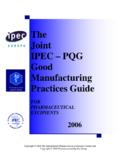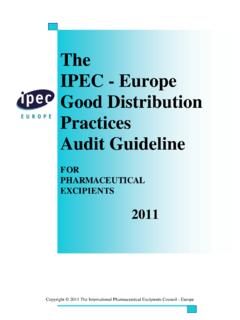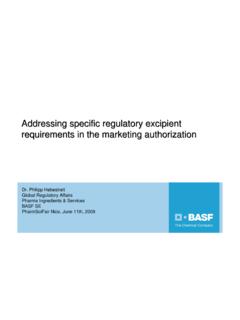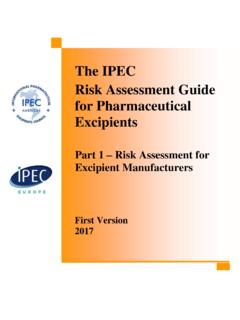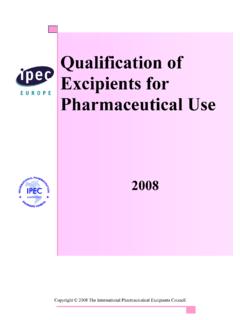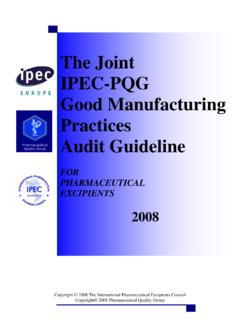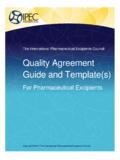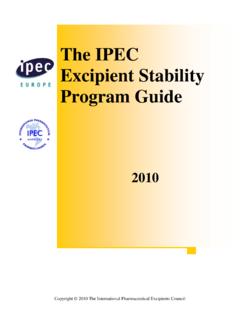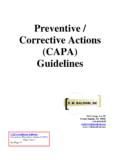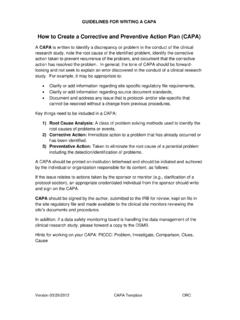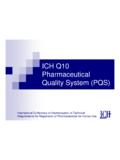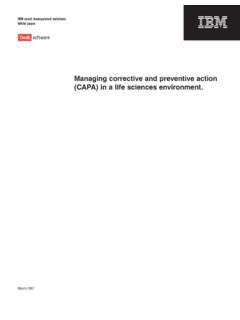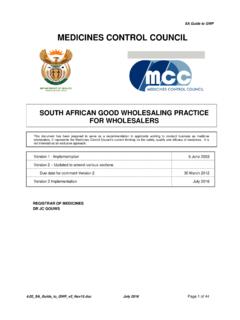Transcription of IPEC EUROPE HOW-TO DOCUMENT Guidelines of …
1 IPEC EUROPE HOW-TO DOCUMENT Guidelines of 19 March 2015 on the formalised risk assessment for ascertaining the appropriate good manufacturing practice for excipients of medicinal products for human use (OJ 2015/C 95/02) Page 2 of 36 FOREWORD This HOW-TO guide was developed by representatives of member companies of the International Pharmaceutical Excipients Council EUROPE IPEC EUROPE . Initially created in 1992, IPEC EUROPE is a not-for-profit association that brings together producers, distributors and Users of pharmaceutical excipients. IPEC EUROPE offers a unique forum to its members to exchange good practices and to develop harmonised standards for pharmaceutical excipients.
2 The company representatives who contributed to this HOW-TO guide, 2016 version, are: Kaat Bracquin , Capsugel Frederik De Vos, Janssen Pharmaceutica Laurence Galichet, Tereos Geertrui Haest, Cargill Frithjof Holtz, Merck Armand Janssen, DMV International Karl Kuma, AstraZeneca Frank Milek, Aug. Hedinger Iain Moore, Croda Dan Pearce, Catalent Pharma Solutions Andreas Pfrengle, Grace Patricia Rafidison, Dow Corning Angelica Rambaldi, Cargill Beverley Stout, GSK Allan Whiston, QA Resolutions Michele Zandi, Cargill This DOCUMENT offers a way to apply the EU Guidelines of 19 March 2015 on the formalised risk assessment for ascertaining the appropriate good manufacturing practice for excipients of medicinal products for human use (OJ 2015/C 95/02) and represents IPEC EUROPE views and interpretation only.
3 IPEC EUROPE would like to stress that the content of its guide should neither be interpreted as regulatory requirements nor be considered as being endorsed by any legal authorities. This is a voluntary guide to help manufacturing authorisation holders and also producers and distributors of excipients. Alternative approaches to those described in this guide may be implemented. Definitions of the terms in bold can be found in the IPEC Federation General Glossary of Terms and Acronyms. Page 3 of 36 TABLE OF CONTENTS FOREWORD .. 2 ACRONYMS .. 4 1. Introduction .. 5 2. Preamble .. 6 3. The Risk Assessment Process .. 6 The Team: responsibilities, qualifications, training .. 7 The Plan .. 7 Data and Information Gathering.
4 7 Internal data gathering .. 8 External data gathering .. 8 Risk Assessment Tools .. 8 Risk Types / Categories .. 8 Conducting risk 9 Output ..10 4. Risk mitigation activity including communication with the Suppliers .. 11 5. Residual risks resolution ( Excipient risk classification) .. 12 Multiple results for an excipient Users Multiple results for an excipient Suppliers conundrum ..14 Multiple results for an excipient Suppliers and Users Iterations ..15 6. Triggers for risk review .. 15 REFERENCES .. 17 ANNEXES .. 18 ANNEX I - Process Flow of the Formalised Risk Assessment for Ascertaining the Appropriate Good Manufacturing Practice for Excipients of Medicinal Products for Human Use.
5 19 ANNEX II General Documentation Packages or Compliance Declarations ..20 Risk area ..21 ANNEX III Suitability of Risk Assessment tools ..23 ANNEX IV - Excipient Categorisation (grouping of excipients, according to function/route of administration) ..24 ANNEX V - Formalised Excipient Risk Assessment - Reference Table (GMP Principles) ..29 I. GMP principles for excipients under pharmaceutical quality system ..30 II. GMP principles for excipient under food quality system ..33 ANNEX VI -Examples of risk scoring ..36 Page 4 of 36 ACRONYMS Acronyms used in the DOCUMENT : CAPA: corrective And preventive Actions EIP: Excipient Information Package GDP: Good Distribution Practices GMP: Good Manufacturing Practices MAH: Manufacturing Authorisation Holders PRDS: Harmonised IPEC-PQG Excipient Manufacturer Product Regulatory Data Sheet QRM: Quality Risk Management QIP: Quality Improvement Plan TUPP: Technically Unavoidable Particle Profile Page 5 of 36 1.
6 Introduction The Falsified Medicines Directive (2011/62/EU) introduced, in Article 46 (f), a requirement that Manufacturing Authorisation Holders (MAHs) verify that the excipients they use are made according to appropriate Good Manufacturing Practices (GMP) standards. The Directive committed the European Commission to publish Guidelines on the formalised risk assessment for ascertaining the appropriate GMP for excipients of medicinal products for human use (Article 47) and these were published on 19 March 2015 (OJ 2015/C 95/02). The goal of the Guidelines is to assure patient safety through the evaluation of risks and application of suitable GMPs to the manufacture and supply of each excipient.
7 Manufacturing Authorisation Holders needed to be fully compliant with the new Guidelines by 21 March 2016. The Guidelines require each excipient used to be assessed for the risks the excipient poses to the quality and purity of the medicinal product, and from these risks to determine the appropriate GMPs which are needed for mitigation. These GMP requirements should then be compared to those applied by each supplier of that excipient. The status of the GMP applied by the supplier should be determined and hence their overall risk profile confirmed. Steps should then be taken to remedy any shortfalls. A periodic review of the risk assessment is required to ensure it remains current to circumstances.
8 The figure below outlines the steps required in the EU Guidelines (OJ 2015/C 95/02) on the Formalised Risk Assessment for Ascertaining the Appropriate Good Manufacturing Practice for Excipients of Medicinal Products for Human Use. Figure 1: Risk Assessment Process NB: a detailed process flow can be found in Annex I. Page 6 of 36 However, implementation of the Guidelines poses a number of challenges. For example, it should be recognised that quality systems applied during the manufacture of pharmaceutical excipients are diverse and generally based on the material s intended use which may not be primarily as a pharmaceutical excipient. Adjusting current quality systems to the pharmaceutical quality systems outlined in the Guidelines may be problematic for the supplier, particularly as the guidance does not provide any definitions for those quality systems or describe the expectations of regulators.
9 A further problem is that an excipient can be used in many different dosage forms and by many Manufacturing Authorisation Holders which may result in different requirements for a single excipient from one supplier. Therefore, IPEC EUROPE members, including representatives from both Suppliers and Users of excipients have prepared this How to DOCUMENT to help Manufacturing Authorisation Holders comply with the new Guidelines , and to illustrate how excipient suppliers can facilitate the risk assessments and other steps needed for compliance. Use of this IPEC guide should support quick and efficient implementation and avoid duplication of work in the excipient industry.
10 2. Preamble The unique nature of the excipient industry, with its diverse technologies, industrial sources and origins of excipients, demands a risk based approach to the assurance of quality and purity. However, it should be remembered that the risk assessment in the Guidelines is to be applied to both existing as well as new uses of excipients. IPEC EUROPE believes that most of these risk processes and procedures already exist in excipient user organisations, and are already applied to excipients. However, the tools and insights provided in this guide will help users of excipients to proactively address this new GMP compliance assessment. Bearing in mind the EU Guidelines (OJ 2015/C 95/02) have not introduced new or higher requirements for either Users or Suppliers of excipients with Quality Management Systems compliant with IPEC-PQG GMP Guide 2006, EXCiPACT or NSF/IPEC/ANSI-363 2014 standards, the decision to cease supply of excipient or withdraw an existing drug product from the market would be an extraordinary one.
